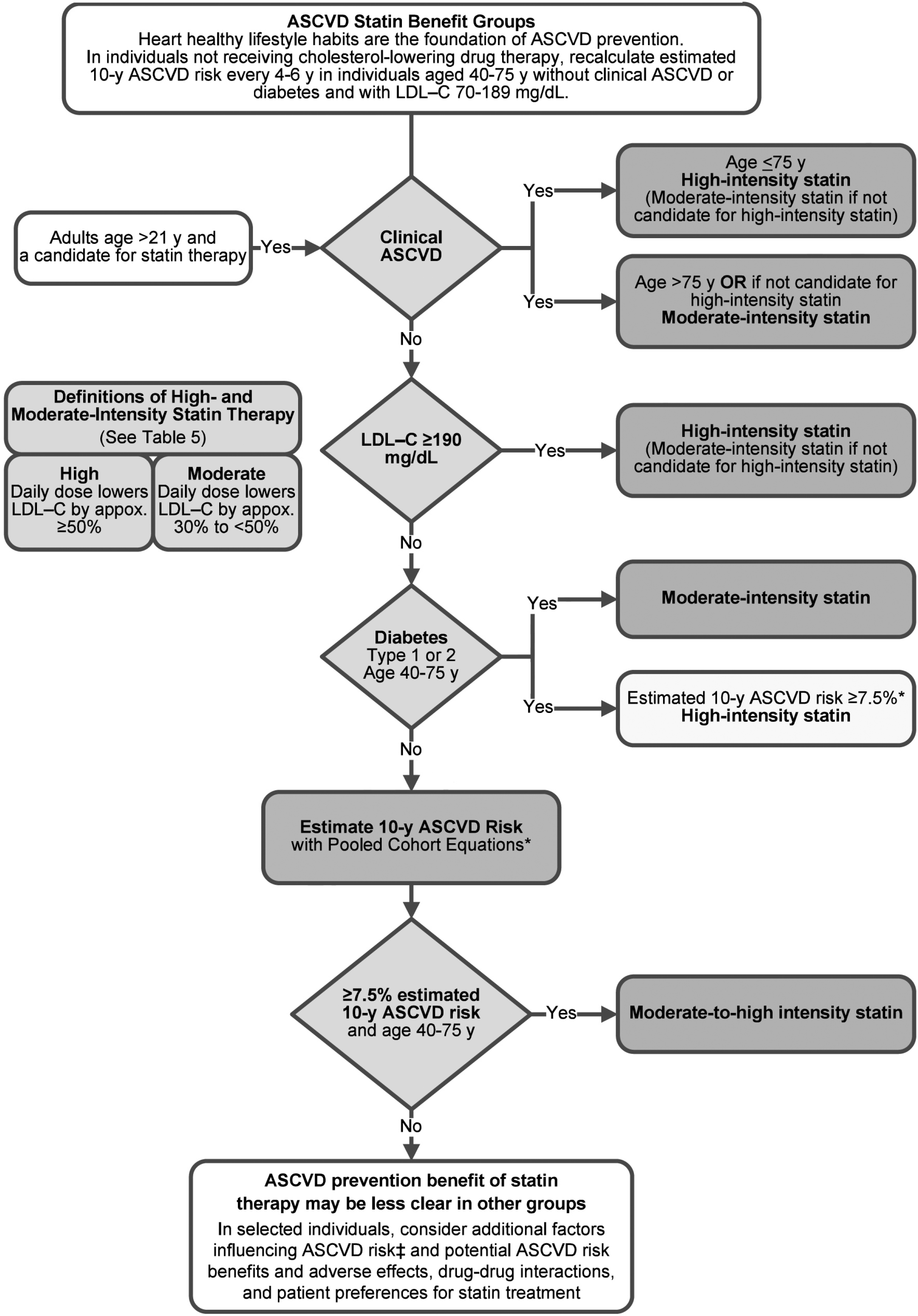Abstract
The recently published 2013 ACC/AHA Guideline on the Treatment of Blood Cholesterol to Reduce Atherosclerotic Cardiovascular Risk in Adults published by the American Heart Association (AHA) and American College of Cardiology (ACC) changes the treatment paradigm for high cholesterol. Based on a systematic review of randomized controlled clinical trials (RCTs), the new guideline no longer targets LDL cholesterol (LDL-C) level but focuses on treating cholesterol to reduce atherosclerotic cardiovascular disease (ASCVD) risk. Only data from RCTs of cholesterol-lowering drug therapies with cardiovascular outcomes or meta-analyses of these RCTs were considered. In Type 2 diabetes in those 40∼75 years of age with risk factors, the potential benefits of LDL–C reduction with a high-intensity statin are substantial. Because those with diabetes often have a lower LDL–C level than those without diabetes, "goal"-directed therapy often encourages use of a lower statin dose than is supported by the RCTs, and non-statin drugs may be included to address low HDL–C or high triglycerides, for which there is little RCT evidence of an ASCVD event reduction.
Go to : 
References
1. Stone NJ, Robinson J, Lichtenstein AH, Bairey Merz CN, Lloyd-Jones DM, Blum CB, McBride P, Eckel RH, Schwartz JS, Goldberg AC, Shero ST, Gordon D, Smith SC Jr, Levy D, Watson K, Wilson PW. 2013 ACC/AHA Guideline on the Treatment of Blood Cholesterol to Reduce Atherosclerotic Cardiovascular Risk in Adults: A Report of the American College of Cardiology/American Heart Association Task Force on Practice Guidelines. J Am Coll Cardiol 2013 Nov 7 [Epub].http://dx.doi. org/10.1016/j.jacc.2013.11.002.
2. American Association of Clinical Endocrinologists. Press Statement [Internet]. Jacksonville: American Association of Clinical Endocrinologists;c2013. [cited 2013 Dec 23]. Available from:. http://media.aace.com/press-release/press-statement.
3. Jellinger PS, Smith DA, Mehta AE, Ganda O, Handelsman Y, Rodbard HW, Shepherd MD, Seibel JA. AACE Task Force for Management of Dyslipidemia and Prevention of Atherosclerosis. American Association of Clinical Endocrinologists' Guidelines for Management of Dyslipidemia and Prevention of Atherosclerosis. Endocr Pract. 2012; 18(Suppl 1):1–78.

4. Perk J, De Backer G, Gohlke H, Graham I, Reiner Z, Verschuren WM, Albus C, Benlian P, Boysen G, Cifkova R, Deaton C, Ebrahim S, Fisher M, Germano G, Hobbs R, Hoes A, Karadeniz S, Mezzani A, Prescott E, Ryden L, Scherer M, Syvänne M, Scholte Op Reimer WJ, Vrints C, Wood D, Zamorano JL, Zannad F. Fifth Joint Task Force of the European Society of Cardiology and Other Societies on Cardiovascular Disease Prevention in Clinical Practice; European Association for Cardiovascular Prevention and Rehabilitation. European Guidelines on cardiovascular disease prevention in clinical practice (version 2012): The Fifth Joint Task Force of the European Society of Cardiology and Other Societies on Cardiovascular Disease Prevention in Clinical Practice (constituted by representatives of nine societies and by invited experts). Atherosclerosis. 2012; 223:1–68.
5. Ray KK, Kastelein JJ, Matthijs Boekholdt S, Nicholls SJ, Khaw KT, Ballantyne CM, Catapano AL, Reiner Z, Lüscher TF. The ACC/AHA 2013 guideline on the treatment of blood cholesterol to reduce atherosclerotic cardiovascular disease risk in adults: the good the bad and the uncertain: a comparison with ESC/EAS guidelines for the management of dyslipidaemias 2011. Eur Heart J. 2014; 35:960–8.

Go to : 
 | Fig. 1.Major recommendations for statin therapy for atherosclerotic cardiovascular disease (ASCVD) prevention. Adapted from Stone NJ, et al. J Am Coll Cardiol 2013[1]. |
Table 1.
High-, moderate- and low-intensity statin therapy (used in the RCTs reviewed by the Expert Panel). Adapted from Stone NJ, et al. J Am Coll Cardiol 2013[1].




 PDF
PDF ePub
ePub Citation
Citation Print
Print


 XML Download
XML Download